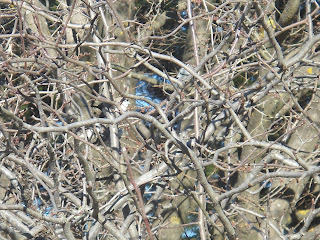 |
I don't know the gender of this bird. It is on my
front lawn. |
This Satin Bowerbird has been a frequent visitor to my front garden, and my neighbour Carol's garden for the passed two months. In the last few days it has disappeared and has not been sighted since.
Satin Bowerbirds arrive in Tenterfield around the 16th of June each year and by the end of July they are gone. However this one stayed longer than normal.
More commonly sighted are the female and juvenile Satin Bowerbirds but only one adult black male seems to visit the south-west area of Tenterfield. Many like the one in the photo arrive as well but over the years the numbers that arrive in Tenterfield has been declining.
In July you can hear the adult male calling but it is elusive and next to impossible to take a photo of. It hides itself in thick bushes or high in the tree tops behind a branch so you cannot see it. The adult male knows you are there but never allows you to see it, or momentarily lapses on it's sense of judgement and you see a flash of black fly passed overhead.
When the adult male is here it eats berries from this bush below, which is in my neighbour, Carol's garden.
 |
| The bush is much bigger in real life. |
 |
| The berries are finished and are now going to seed. |
No Satin Bowerbirds breed in Tenterfield as I have never seen them in Summer which is when their breeding season is. One thing I do know about Satin Bowerbirds is they love apples and will gobble up apple pieces quickly before any other bird eats them.
Because this particular Satin Bowerbird (see photo at top) hung around for a while, it treated most of the local birds with respect. However, it recently encountered a pair of Rainbow Lorikeets which it took a great disliking to, and attacked both Lorikeets every moment it got when they were eating the seed in Carol's bird feeder. I have never seen the Satin Bowerbird actually eat seed from the bird feeder so I cannot explain why it would attack just two birds in the bird feeder and not any other birds like the Australian King Parrots or Eastern Rosellas that were also present in the tree at the time.
The following 4 photos was taken from one of the Rainbow Lorikeet videos taken on 14 August 2012. It shows the Satin Bowerbird deliberately attacking the Rainbow Lorikeet, jumping onto the tree branches in the middle of the tree then turning around and having a second attack at the bird. It also attacked the other Lorikeet higher up in the tree branches. It obviously did not like the Rainbow Lorikeets being there.
 |
| Shot 1 |
 |
| Shot 2 |
 |
| Shot 3 |
 |
| Shot 4 |
I guess I'll have to wait until next year before I can add something else about Satin Bowerbirds in Tenterfield. I doubt this one bird will be returning in a hurry.


































